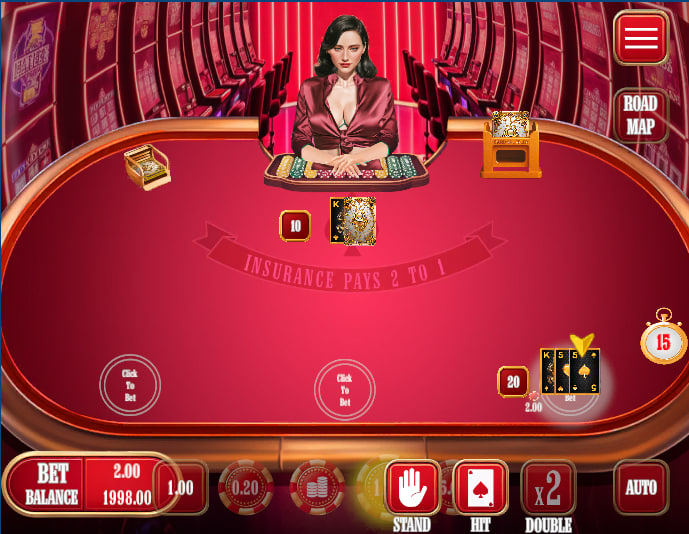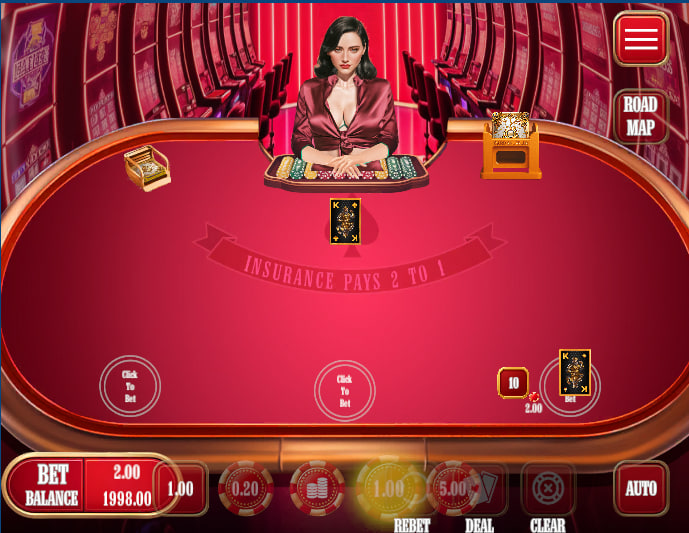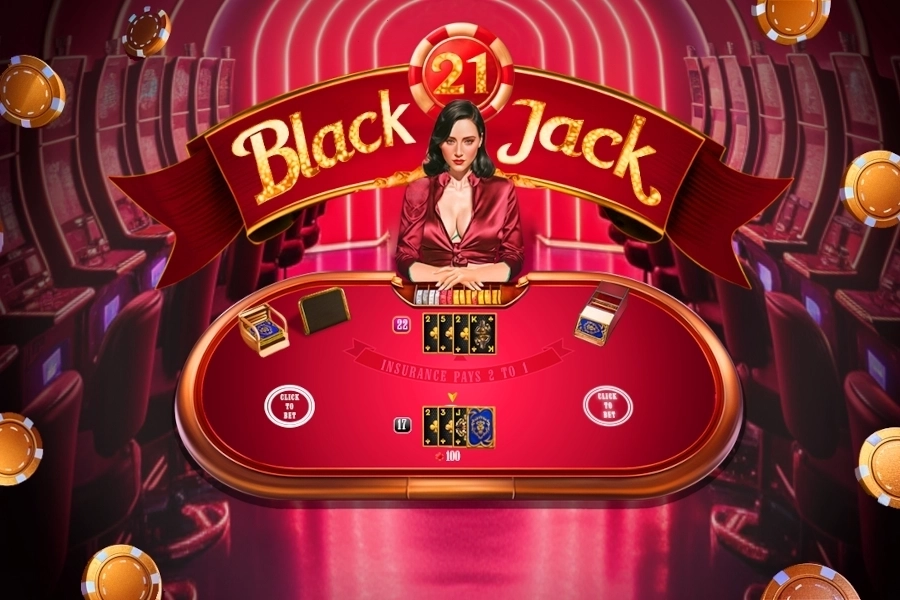GameTimeTec’s Blackjack presents a functional and streamlined casino environment, built around a stark, red-felt digital table. The atmosphere is one of clinical efficiency, favoring rapid gameplay over thematic immersion. Its core design uses an eight-deck shoe that is completely reshuffled after every hand is complete. This fundamental rule defines the experience, making card counting impossible and isolating each round as a statistically independent event. The game’s mathematical structure operates with a stated theoretical RTP of 97%, establishing a 3% house edge that is notably higher than many other digital Blackjack variants. Player-favorable rules, such as the dealer standing on all 17s and the ability to double down after a split, offer some strategic leverage. However, the dominant feature remains the high house advantage. A natural Blackjack correctly pays at the standard 3-to-2 odds. The game serves as a direct and unembellished platform for testing one’s adherence to perfect Basic Strategy.
GameTimeTec presents a digital Blackjack environment that opts for a streamlined, almost clinical, execution over thematic extravagance. The setting is an abstraction of a high-stakes casino floor, with rows of empty tables receding into a softly lit background. The primary focus is a stark, crimson-felt table. A pre-rendered female dealer anchors the visual experience; she is static, a non-interactive centerpiece whose presence serves to maintain the casino aesthetic without the operational complexities of a live-dealer feed. This design choice results in a very fast-paced, predictable gameplay loop, devoid of the interpersonal elements or potential distractions of live games.
The user interface is built for efficiency. Bet selection is handled through a standard array of chips, and the primary actions—Deal, Hit, Stand, Double—are presented as large, unambiguous buttons that appear contextually. The game operates on a brisk 15-second timer for player decisions, a feature that enforces a steady rhythm and prevents prolonged inactivity. The overall presentation is functional and clean, a software-driven simulation that prioritizes mechanical execution above all else. It is a workhorse, not a showpiece, designed for rapid, uninterrupted hands.

Core Gameplay and Table Rules
The game's engine is built upon a specific and unyielding set of rules. An eight-deck shoe is used, a common configuration for digital blackjack. However, the most strategically significant rule is that the entire shoe is reshuffled after the conclusion of every single hand. This mechanic fundamentally defines the nature of the game, rendering it a series of independent, statistically isolated events. Consequently, any form of advantage play that relies on tracking the composition of the remaining deck, such as card counting, is completely nullified. Each hand begins with a mathematically perfect 8-deck shoe.
The dealer operates under a strict, non-deviating protocol. She will continue to draw cards until her hand total reaches 17 or greater. Crucially, the rules stipulate that the dealer stands on all totals of 17, including soft 17 (a hand containing an Ace counted as 11). This is a moderately favorable rule for the player compared to the alternative where the dealer hits on a soft 17. Player actions are governed by a familiar set of options. Doubling down is permitted on initial two-card hands. Splitting is allowed, but only once per hand. A valuable inclusion is the ability to Double After a Split (DAS), a rule that slightly improves the player's return when correctly applied. When splitting a pair of Aces, however, a common restriction applies: only one additional card is dealt to each new hand, immediately after which the hands stand.
The Statistical Foundation: RTP and Payout Structure
The single most defining characteristic of GameTimeTec's Blackjack, and the one that demands the most scrutiny from an experienced player, is its stated theoretical Return to Player (RTP) of 97%. In the world of Blackjack, where optimal strategy can often push the RTP above 99.5%, a figure of 97% is an outlier. A 3% house edge is exceptionally high for this game and positions it closer to the statistical profile of a slot machine than a traditional table game. This figure suggests that even with flawless execution of Basic Strategy, the mathematical expectation is significantly lower than what is achievable in many competing digital Blackjack variants.
Despite the low RTP, the game adheres to the most important positive payout convention: a natural Blackjack pays at odds of 3 to 2. This is a critical detail, as the proliferation of 6:5 payout tables has been detrimental to players' odds across the industry. The presence of a 3:2 payout is a positive attribute. However, its benefit is seemingly counteracted by other, less transparent factors within the game's mathematical model that result in the final 97% RTP figure. The insurance side bet, as is standard, pays 2 to 1 but remains a mathematically unsound proposition for a player not engaged in card counting.
User Interface and Distinguishing Elements
Beyond the core rules, the interface presents a few elements of note. The “Auto” button suggests a feature that allows the game to play through hands automatically. For a game predicated on strategic choice, the utility of such a feature is questionable, perhaps intended for players who wish to see outcomes based on a fixed strategy over many hands, or simply for hands-off play. Its inclusion is an unusual choice for a game like Blackjack.
The most peculiar interface feature is the “Road Map” button. Roadmaps (like the Big Road or Cockroach Road) are visual tracking systems almost exclusively associated with Baccarat. They are designed to display historical outcomes, allowing players to search for perceived patterns or trends. In a Baccarat game with a continuous shoe, this has some (albeit limited) predictive value. In this Blackjack game, where the shoe is reshuffled every hand, the roadmap is mathematically meaningless. It serves purely as a psychological comfort or a familiar visual for players migrating from Baccarat, but it offers zero strategic insight into the next hand's outcome.

Strategic Considerations and Final Verdict
The game's structure dictates a singular, rigid strategic approach. With the impossibility of card counting, the only tool at a player's disposal is Basic Strategy. Every decision—hit, stand, double, or split—should be made in strict accordance with a Basic Strategy chart tailored for an 8-deck game where the dealer stands on all 17s and DAS is allowed. There is no room for intuition, deviation, or advanced techniques. The game is a pure, dispassionate test of one's ability to memorize and apply these mathematical principles without error.
In conclusion, GameTimeTec's Blackjack is a functional, if uninspired, digital simulation of the game. It runs smoothly, the rules are clearly defined, and it includes some favorable player options like DAS and a 3:2 Blackjack payout. However, these positives are overshadowed by two dominant factors: the reshuffle after every hand, which strips the game of any deep strategic element beyond Basic Strategy, and the exceptionally low 97% RTP.
For a player looking to practice Basic Strategy in a fast-paced environment, this game serves that purpose adequately. For the seasoned player whose goal is to engage with the game on a deeper level or to seek out the best possible odds, the 3% house edge is a significant deterrent. The game exists as a simplified Blackjack experience, but its statistical profile makes it a demonstrably inferior choice when compared to the multitude of other online variants that offer a much smaller house advantage. It is a game to approach with a clear understanding of its inherent mathematical limitations.













